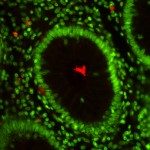Link to Pubmed [PMID] – 3110785
Proc. Natl. Acad. Sci. U.S.A. 1987 Aug;84(15):5207-10
Comparison of the amino acid sequence of Bacillus subtilis threonine synthase with the National Biomedical Research Foundation protein sequence library revealed a statistically significant extent of similarity between the sequence of the tryptophan synthase beta chain from various organisms and that of threonine synthase. This homology in the primary structure of threonine synthase and tryptophan synthase beta chain, which catalyze the last step in the threonine and the tryptophan biosynthetic pathways, respectively, correlates well with some of their catalytic properties and indicates that they have evolved from a common ancestor. The evolutionary relationship between these enzymes supports the hypothesis that primitive enzymes possessed a broad substrate specificity and were active in several metabolic pathways.
